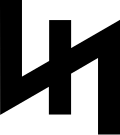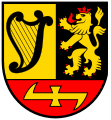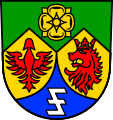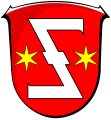


Вольфсангель (нем. Wolfsangel [ˈvɔlfsˌʔaŋəl] — букв. волчий крюк) — внеалфавитный символ. Используется в геральдике, присутствует на гербах ряда городов. Также применялся в нацистской и применяется в неонацистской символике[1][2].
Происхождение
Предположительно происходит от средневекового способа ловли волков. Железные крюки соответствующей формы, датируемые XIII веком, были обнаружены археологами на северо-востоке земли Северный Рейн-Вестфалия в 2009 году.[3] Первоначально был магическим символом, который применялся для защиты от оборотней, позже стал использоваться в геральдике, где обозначал волчью яму. В XV веке стал эмблемой крестьянского восстания и некоторое время считался символом свободы и независимости, хотя во время Тридцатилетней войны назывался также знаком «распутной тирании».[4]
Геральдика

- Герб Бургведеля
- Герб Ведемарка
- Район Равенсбурга
- Герб Вольфштайна
- Герб Дассендорфа
- Герб Дернбаха
- Герб Зиббессе
- Герб Идар-Оберштайна
- Герб Ильфесхайма
- Герб Клайнблиттерсдорфа
- Герб Мангейма
- Герб Марпингена
- Герб Момменхайма
- Герб Франкфурта-Борнхайма
- Герб Эппельборна
- Герб Эрвитте
- Герб Эстрих-Винкеля
Кроме того, Вольфсангель наносился на приграничные (межевые) камни в качестве гербового или защитного знака от сил зла; для защиты собственности[5].
Воинская и нацистская символика
В 1910 году немецкий писатель Герман Лёнс (Hermann Löns) опубликовал роман «Вервольф», повествующий о крестьянском отряде самообороны в период Тридцатилетней войны. Тон романа, воспевающего доблестное сопротивление оккупантам, сделал его популярным в 1920—1930-е годы, стал знаменитым и символ Вольфсангель, использовавшийся отрядом как эмблема[6].
C 1918 года «волчий капкан» являлся эмблемой Вюртембергского добровольческого отряда особого назначения — одного из белых добровольческих корпусов, командовал которым подполковник Гретер[7].
Вариант «волчьего капкана» был некоторое время эмблемой голландской нацистской партии[8].
Первое время служил эмблемой НСДАП[4]. Впоследствии Вольфсангель был выбран эмблемой (тактическим знаком) танковой дивизии СС «Дас Райх». Кроме того, этот знак в различных вариациях использовался в других подразделениях СС и вермахта, в частности, 34-й добровольческой гренадерской бригаде «Ландсторм Недерланд» (дивизионная эмблема и петличный знак) и других[7]. Вертикальный Вольфсангель в зеркальном отображении являлся эмблемой 4-й полицейской гренадерской дивизии СС.
- Эмблема дивизии СС «Дас Райх»
- Эмблема дивизии «Ландсторм Недерланд»
- Эмблема 4-й полицейской гренадерской дивизии СС
Современное использование
Применяется в неонацистской символике. В Германии символ официально не запрещён, кроме случая использования в качестве символики запрещённой неонацистской организации «Юнге фронт» (нем. Junge Front, JF)[1][2]. Символ используется ультранационалистической организацией «Иранский Арийский Национальный Фронт»[9], использовался шведской неонацистской организацией «Белое Арийское Сопротивление» (Vitt Ariskt Motstånd)[10].
Политолог Андреас Умланд отмечает, что использующие зеркальный Вольфсангель (образует монограмму из сочетания латинских букв «I» и «N», интерпретируется как лозунг «Идея Нации») могут заявлять, что он не имеет отношения к нацизму[11]. По словам руководителя украинской военизированной организации «Патриот Украины» Андрея Билецкого, при выборе символа они руководствовались исключительно украинским его содержанием без ссылок на средневековую немецкую геральдику, а тем более — на символику национал-социалистической Германии[12]. В частности, эмблема в зеркальном виде:
- является символом американской расистской и террористической организации «Арийские нации» (Aryan Nations)[10].
- являлся логотипом (1991—2003) Социал-национальной партии Украины (СНПУ).
- является логотипом украинской неонацистской[13][14][15][16][17][18][19] организации «Патриот Украины»
- присутствует в эмблеме украинской неонацистской[20][21][22][23][13], расистской[23][24][25] организации «Социал-национальная ассамблея».
- присутствует в эмблеме полка Национальной гвардии Украины «Азов». Символ декларируется ими как монограмма «Идея нации» — наложенные друг на друга украинские буквы «I» (укр. Ідея) и «N» (укр. Nації) в историческом начертании[26].
- используется[источник не указан 1109 дней] в символике Национального института стратегических исследований при президенте Украины[27].
Также в горизонтальном изображении иногда используется организацией Церковь Сатаны[28]
- Эмблема Социал-национальной ассамблеи
- Символ организации «Патриот Украины».
- Эмблема полка «Азов».
Примечания
- 1 2 In Deutschland verbotene Zeichen und Symbole. Informations- und Dokumentationszentrum für Antirassismusarbeit in Nordrhein-Westfalen.
- 1 2 Verbotene Organisationen. Programm Polizeiliche Kriminalprävention.
- ↑ Erstmals Wolfsangeln in Westfalen-Lippe gefunden — Mitteilung, LWL-Presse-Info, 30.10.2009.
- 1 2 Хайнц Хёне. Чёрный орден СС. История охранных отрядов. — М.: ОЛМА-ПРЕСС, 2003. — с. 493.
- ↑ Die Wolfsangel // WolfHall, 28.12.2011. (нем.)
- ↑ Акунов, В. Белые рыцари.
- 1 2 Акунов, В. Танковая дивизия СС «Дас Рейх». История второй дивизии войск СС (1939—1945 гг.)
- ↑ NSB (The Netherlands)
- ↑ Bezpieczeństwo. Teoria i praktyka 2011/3 edited by Klemens Budzowski
- 1 2 Political Flags of Extremism — Part 1
- ↑ Андреас Умланд, Что означают нацистские символы, из-за которых оштрафовали «Арену Львов» (согласованная версия статьи на Forbes.ua) (недоступная ссылка — история, копия)
- ↑ Евгений Швец. Андрей Билецкий: «Половина „Азова“ говорит на русском языке. Но они умирают и убивают за Украину», «LB.ua», 10.12.2014.
- 1 2 Likhachev, Viacheslav (September–October 2013). “Right-Wing Extremism on the Rise in Ukraine”. Russian Politics and Law. 51 (5). DOI:10.2753/RUP1061-1940510503.
- ↑ Ishchenko, Volodymyr (2011). “Fighting Fences vs Fighting Monuments: Politics of Memory and Protest Mobilization in Ukraine”. Debatte: Journal of Contemporary Central and Eastern Europe. 19 (1–2).
- ↑ Андреас Умланд, Антон Шеховцов. Украинские правые радикалы, евроинтеграция и неофашистская угроза // Полит.ру, 21.05.2014.
- ↑ Лилия Ржеутская. Вадим Троян: «дурная репутация неонациста» может навредить Украине // Deutsche Welle, 20.11.2014.
- ↑ BBC: Ukraine underplays role of far right in conflict (англ.) // BBC News, Kiev, 13.12.2014.
- ↑ The Guardian: Ukraine has ignored the far right for too long — it must wake up to the danger Volodymyr Ishchenko (англ.) // The Guardian, 13.11.2014
- ↑ Rechtsradikaler wird Polizeichef in Kiew (нем.), Die Welt, 12.11.2014
- ↑ Shekhovtsov, Anton. 17: From Para-Militarism to Radical Right-Wing Populism: The Rise of the Ukrainian Far-Right Party Svoboda // Right-Wing Populism in Europe / Ruth Wodak. — Bloomsbury Academic, 2013. — P. 249–263. — ISBN 1780932456. — «At the same time, Nova Syla’s Yuriy Zbitnyev is one of the leaders of the neo-Nazi group Social-National Assembly, an organization that is also close to the younger members of Svoboda, but Nova Syla itself, while remaining on the fringes of Ukrainian politics, is not much influenced by these relations…. Svoboda also seems to benefit from the increasing popularity of extreme-right youth movements and organizations like the Social-National Assembly (S.N.A), 'Patriot of Ukraine' and Autonomous Resistance, whose aim is to create 'a uniracial and uninational society'. The activities of these groups are not limited to physical or symbolic violence against ethnic and social minorities, as they also take an active part in numerous social campaigns — generally along with representatives of Svoboda — ranging from mass protests against price rises to leafleting against alcohol and drug use. Needless to say, members of these extreme-right movements are often members of Tyahnybok’s party. Interestingly, 'street combat youth movements' like the S.N.A no longer focus on ethnic issues: in contrast to the older Ukrainian far right, the new groups are, first and foremost, racist movements.»
- ↑ Neonazis im Häuserkampf // Frankfurter Rundschau vom 10. August 2014
- ↑ Ishchenko, Volodymyr (2011). “Fighting Fences vs Fighting Monuments: Politics of Memory and Protest Mobilization in Ukraine”. Debatte: Journal of Contemporary Central and Eastern Europe. 19 (1–2).
...rightist non-partisan groups including overtly racist “autonomous nationalists” (http://reactor.org.ua) and the neo-Nazi “Patriot of Ukraine” (http://www.patriotukr.org.ua/). For the far right sector politics of memory actions comprised 29.2% of all protest actions with their participation, this was larger than the shares of social-economic, political struggle, and civic rights protest issues (Table 7)… After the notorious death of Maksym Chaika in a fight with antifascists in Odessa in April 2009, Yushchenko unambiguously supported the far right interpretation of the accident claiming the victim to be “an activist of a patriotic civic association” consciously murdered by “pro-Russia militants” ignoring Chaika’s connections with rightist football hooligans and his membership in the “SICH” (“Glory and Honor”) organization, a participant in the Social-Nationalist Assembly (http://sna.in.ua/) together with the neo-Nazi group “'Patriots of Ukraine.'"
- 1 2 Ghosh, Mridula. The Extreme Right in Ukraine’s Political Mainstream: What Lies Ahead? / Ralf Melzer. — Friedrich Ebert Stiftung, 2013. — «In its own internal flows of communication and control, Svoboda has always been a top-down organization that does not permit dialogue or encourage critical thinking and dissent. Yet it has made good use of “open” forms of grassroots exchanges, communicating with the public and attracting new recruits via social networks like YouTube, Facebook, Twitter and VKontakte. In this context, special mention should be made of the relations that Svoboda has maintained with what may be called the “informal” far-right, a category that includes the neo-Nazi underground, radical football fans, and hooligans. Members of these groups constitute hidden reservoirs of support for Svoboda and its ideology, Among them are those who openly propagate intolerance (e.g., by supporting total bans on immigrants, refugees, and asylum seekers), including one part of UNA-UNSO; the Ukrainian National Labor Party and Patriots of Ukraine; skinheads; followers of Hetman Pavel Skoropadskiy; Fans of the Third Hetmanate; and the Delegation of the Right from the regions. There are also those who do not champion racism, xenophobia and anti-Semitism, but nevertheless harbor other radical ideas...».
- ↑ Shekhovstov, Anton (March 2011). “The Creeping Resurgence of the Ukrainian Radical Right? The Case of the Freedom Party”. Europe-Asia Studies. 63 (2): 203—228. DOI:10.1080/09668136.2011.547696.
During the second half of the 1990s, the SNPU recruited Nazi skinheads and football hooligans. At the same time, the party decided to reorganise its ‘popular guard units’ to form the Tovarystvo spryyannya zbroinym sylam ta viiskovo-mors’komu flotu Ukrayiny ‘Patriot Ukrayiny’ (Society of Assistance to Armed Forces and Navy of Ukraine ‘Patriot of Ukraine’), headed by Andrii Parubii. However, although the ‘Patriot of Ukraine’ was formed in 1996, it was not until 1999 that it became a full-fledged organisation. Its first convention took place in Lviv in December 1999 and was celebrated by a night-time torch procession through the city streets… [In 2004, the SNPU] the convention disbanded the Patriot of Ukraine, as this paramilitary organisation as such and its overtly racist stances in particular posed a threat to the new ‘respectable’ image of the Freedom Party… The Kharkiv local organisation of the Patriot of Ukraine refused to disband and renewed its membership in 2005. The following year, it managed to register as a regional social organisation, but, from then on, it had no organisational ties with the maternal party.
- ↑ Shekhovstov, Anton. 17: Para-Militarism to Radical Right-Wing Populism: The Rise of the Ukrainian Far-Right Party Svoboda. // Right-Wing Populism in Europe / Wodak. — Bloomsbury Academic, 2013. — «Svoboda also seems to benefit from the increasing popularity of extreme-right youth movements and organizations like the Social-National Assembly (SNA), 'Patriot of Ukraine' and Autonomous Resistance, whose aim is to create 'a uniracial and uninational society'. The activities of these groups are not limited to physical or symbolic violence against ethnic and social minorities, as they also take an active part in numerous social campaigns - generally along with representatives of Svoboda - ranging from mass protests against price rises to leafleting against alcohol and drug use. Needless to say, members of these extreme-right movements are often members of Tyahnybok's party. Interestingly, 'street combat youth movements' like the SNA no longer focus on ethnic issues: in contrast to the older Ukrainian far right, the new groups are, first and foremost, racist movements.».
- ↑ Ідея Nації: символіка і традиція // Соціал-Національна Асамблея, 16.03.2014. (укр.)
- ↑ :: Національний інститут стратегічних досліджень
- ↑ Chris Mathews, Modern Satanism: Anatomy of a Radical Subculture, p.111.
| Вольфсангель на Викискладе |
Данная страница на сайте WikiSort.ru содержит текст со страницы сайта "Википедия".
Если Вы хотите её отредактировать, то можете сделать это на странице редактирования в Википедии.
Если сделанные Вами правки не будут кем-нибудь удалены, то через несколько дней они появятся на сайте WikiSort.ru .























